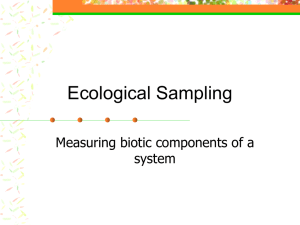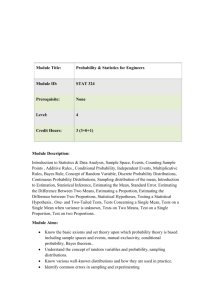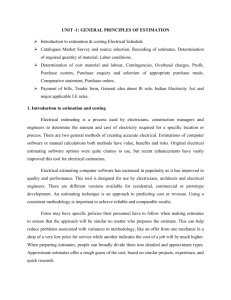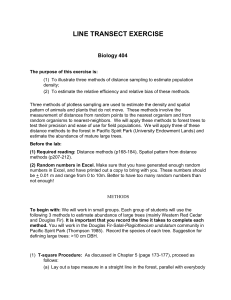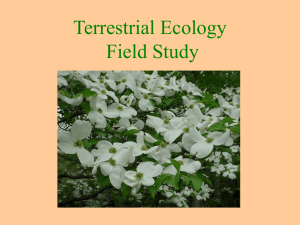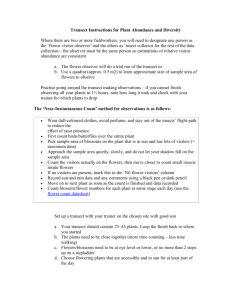JOURNAL OF APPLIED MATHEMATICS AND DECISION SCIENCES, 6(4), 213–228 Copyright c
advertisement
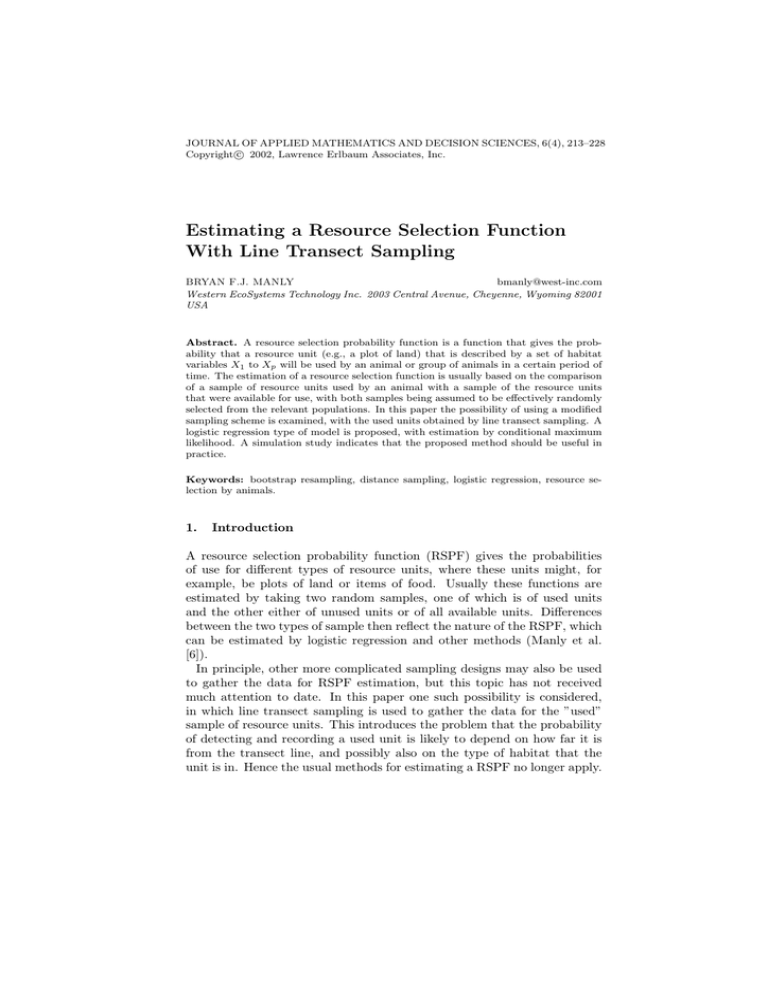
JOURNAL OF APPLIED MATHEMATICS AND DECISION SCIENCES, 6(4), 213–228
c 2002, Lawrence Erlbaum Associates, Inc.
Copyright
Estimating a Resource Selection Function
With Line Transect Sampling
BRYAN F.J. MANLY
bmanly@west-inc.com
Western EcoSystems Technology Inc. 2003 Central Avenue, Cheyenne, Wyoming 82001
USA
Abstract. A resource selection probability function is a function that gives the probability that a resource unit (e.g., a plot of land) that is described by a set of habitat
variables X1 to Xp will be used by an animal or group of animals in a certain period of
time. The estimation of a resource selection function is usually based on the comparison
of a sample of resource units used by an animal with a sample of the resource units
that were available for use, with both samples being assumed to be effectively randomly
selected from the relevant populations. In this paper the possibility of using a modified
sampling scheme is examined, with the used units obtained by line transect sampling. A
logistic regression type of model is proposed, with estimation by conditional maximum
likelihood. A simulation study indicates that the proposed method should be useful in
practice.
Keywords: bootstrap resampling, distance sampling, logistic regression, resource selection by animals.
1.
Introduction
A resource selection probability function (RSPF) gives the probabilities
of use for different types of resource units, where these units might, for
example, be plots of land or items of food. Usually these functions are
estimated by taking two random samples, one of which is of used units
and the other either of unused units or of all available units. Differences
between the two types of sample then reflect the nature of the RSPF, which
can be estimated by logistic regression and other methods (Manly et al.
[6]).
In principle, other more complicated sampling designs may also be used
to gather the data for RSPF estimation, but this topic has not received
much attention to date. In this paper one such possibility is considered,
in which line transect sampling is used to gather the data for the ”used”
sample of resource units. This introduces the problem that the probability
of detecting and recording a used unit is likely to depend on how far it is
from the transect line, and possibly also on the type of habitat that the
unit is in. Hence the usual methods for estimating a RSPF no longer apply.
214
B. MANLY
The combination of having a line transect sample of used units and a
random sample of available units does not seem to have been considered
before, although methods for allowing for the probability of detection of
a used unit to depend on the type of unit that it is have been used with
ordinary line transect sampling (Beavers and Ramsey [1]). The advantage
of using the two types of sampling that are discussed in the present paper
is that it is possible to estimate both the RSPF and the total number of
animals using the units.
In the next section of this paper a justification for using logistic regression
for estimating a RSPF is given when the data available consists of a random
sample of used units and a random sample of available units. Section 3
then suggests how this approach can be modified with data collected from
line transect sampling, leading to a logistic regression type of model, with
estimation of both the RSPF and the number of individuals in the area
being studied. The properties of this model are examined by a simulation
study in Section 4, and finally conclusions are summarised in Section 5.
2.
Estimating a Resource Selection Probability Function From
Random Samples
Suppose that there is a set of N resource units (e.g., plots of land) available
for use by either a single animal or a group of animals, with each unit being
described by the values that it possesses for some variables X1 , X2 , ... Xp
(e.g. the altitude, the percentage of the unit covered by grasslands, or the
density of a certain type of tree). Suppose also that the probability of use
for one of the resource units depends on the values that the unit possesses
for the X variables. Then the RSPF gives this probability, and its value
for the ith resource unit can be written as w ∗ (xi ), where this unit has the
values xi = (xi1 , xi2 , ..., xip ) for the X variables.
Next, assume that the sampling scheme is such that every available unit
has a probability Pa of being sampled, and every used unit has a probability
Pu of being sampled. Further, assume that the available units are sampled
first, without replacement. In that case, the probability of a unit being
recorded as used is (1 − Pa ) w∗ (xi )Pu and the probability of a unit being
in either the available or the used sample is
Prob(ith unit sampled) = Pa + (1 − Pa )w∗ (xi )Pu .
(1)
ESTIMATING A RESOURCE SELECTION FUNCTION
215
It then follows that the probability that the ith unit is in the used sample,
given that it is in one of the two samples, is
Prob(used and sampled)
Prob(sampled)
(1 − Pa )w∗ (xi )Pu
=
.
Pa + (1 − Pa )w∗ (xi )Pu
Prob(ith unit used sampled) =
(2)
It is convenient at this point to let the RSPF take the particular form
w∗ (xi ) = exp(β0 + β1 xi1 + β2 xi2 + ... + βp xip ),
(3)
where the argument of the exponential function must be negative. Letting
θ(xi ) denote the probability on the left-hand side of equation (2), it then
follows that
θ(xi ) =
exp{loge [Pu (1 − Pa )/Pa ] + β0 + β1 xi1 + ... + βp xip }
. (4)
1 + exp{loge [Pu (1 − Pa )/Pa ] + β0 + β1 xi1 + ... + βp xip }
This is a logistic regression equation in which the parameter β0 is modified
by the correction term loge [Pu (1 − Pa )/Pa ] to allow for available and used
resource units being sampled with different probabilities.
Assuming independence of observations, the probability of observing resource unit i as used is θ(xi ) and the probability of observing it as available
is 1 − θ(xi ). Let yi be an indicator of whether a sampled unit was used.
That is, yi = 0 if sampled unit i came from the available sample, and
yi = 1 if unit i came from the sample of used units. Using the y values as responses, any standard logistic regression programs can be used to
estimate the coefficients β0 , β1 , ..., βp and their approximate variances.
The fact that the constant in the logistic regression is loge [Pu (1−Pa )/Pa ]+
β0 means that if the Pu and Pa are known then the parameter β0 in the
RSPF can be estimated by subtracting loge [Pu (1 − Pa )/Pa ] from the estimated constant in the logistic regression equation. If Pu and Pa are not
known then β0 cannot be estimated, but it is still possible to estimate the
resource selection function (RSF)
w(x) = exp{β1 x1 + β2 x2 + ... + βp xp }
(5)
and use this to compare resource units. In practice there is little loss from
using the RSF rather than the RSPF because the RSF provides values
that are proportional to probabilities of use. This is all that is needed
to determine which types of resource unit are apparently favoured by the
animals being studied, produce maps of habitat use, etc. (Manly et al. [6]).
216
3.
B. MANLY
Estimation with Distance Sampling
It will now be assumed that the situation described in the previous section
is modified because the used sample is obtained by line transect sampling,
although the available sample is randomly selected, as before. It is envisaged that the available sample might be collected by recording habitat
information on randomly selected resource units during the line transect
sampling, or possibly at a different time. The available sample might even
be obtained from the data in a geographical information system.
The probability of resource unit i being used is still given by the RSPF,
w∗ (xi ), which is assumed to be unrelated to the distance of the resource unit
from the transect line. However, the probability of the use being recorded
will generally depend on the distance, di , of the unit from the line, and
may also depend on the nature of the unit as defined by the variables in
the RSPF. Hence, this probability of recording unit i if it is used will be
denoted by g(di , xi ). The probability of the ith unit being either included
in the available sample or in the used sample then becomes
Pa + (1 − Pa )w∗ (xi )g(di , xi ),
(6)
assuming, as before, that the available units are sampled first with probability Pa , without replacement. Consequently, the probability of the ith
unit appearing in the used sample, given that it is in one of the samples, is
θ(xi , di ) = (1 − Pa )w∗ (xi )g(di , xi )/{Pa + (1 − Pa )w∗ (xi )g(di , xi )}
(7)
At this stage some specific assumptions about the form of the functions
become useful. It will therefore be assumed that the RSPF is as given in
equation (3), while the other function takes the form
g(di , xi ) = exp{−di (γ0 + γ1 xi1 + γ2 xi2 + ... + γp xip )}.
(8)
These assumed parametric forms for the functions are arbitrary, and are
used here because they are convenient to develop the ideas being presented.
Other functions could well be used instead, should this be necessary.
What can be noted is that equation (3) for the RSPF has often been used
in the past, and the important characteristic is that it is always positive.
Equation (8) for the detection function is also reasonable because g(0, x i ) =
1, so that all used units on the transect line are assumed to be recorded,
and as the distance from the line increases the probability of recording a
use decreases for all types of units.
Substituting into equation (7) using equations (3) and (8) leads to
θ(xi , di ) =
Ai
1 + Ai
(9)
ESTIMATING A RESOURCE SELECTION FUNCTION
217
which is essentially a non-linear logistic regression model, with 2p + 1 unknown parameters, which are β0 , β1 , ..., βp , γ0 , γ1 , ... and γp , where Ai denotes
exp{β0 + loge [
(1 − Pa )
] − di γ0 + (β1 − di γ1 )xi1 + ... + (βp − di γp )xip }.
Pa
If the value of Pa is known then this can be allowed for when fitting equation
(9) to data. If it is not known then β0 and loge [(1−Pa )/Pa ] are confounded
and only the combined parameter β00 = β0 + loge [(1 − Pa )/Pa ] can be
estimated.
Suppose that the units in the available sample are numbered from 1 to n a ,
and the units in the used sample are numbered from na +1 to na +nu . Then
the likelihood function for the full sample is the product of the probabilities
of the units being in the sample that they were observed in, given that they
were in one of the two samples. This likelihood function is therefore
a +nu
a
θ(xi , di ).
{1 − θ(xi , di )}Πni=1
L = Πni=1
(10)
This can be maximized numerically to obtain the maximum likelihood
estimators of the unknown parameters. For the results presented later this
was done using the algorithm AMOEBA of Press et al. [7].
Transect sampling is usually carried out in order to estimate the number
of individuals in the sampled area. In the present context this means
estimating the total number of used units in the area, assuming that each
used resource unit contains only one animal. There are two obvious moment
estimators that might be used for this purpose when Pa is known. First, if
the average value of the estimated RSPF for the na units in the sample of
available units is ŵa , then
Êa = N ŵa
(11)
is an estimator of the total number of used units. Second, if the ith of the
nu units recorded as being used is at a distance of dj from the transect
line, then a Horvitz-Thompson estimator of the total number of used units
is
u
[1/ĝj ]
Êu = Σnj=1
(12)
(Horvitz and Thompson [4]; Thompson [8], p. 49), where ĝj is the estimated
probability of use being detected for the jth unit.
A simple way to assess the accuracy of the estimators of the parameters
of the RSPF, the distance function, and the two estimators of population
size, is by bootstrap resampling. Use a bootstrap set of data obtained by
resampling the observed available units to obtain a new sample of available
218
B. MANLY
units with the same size as the observed sample, and independently resample the used units to get a new sample of used units, again with the same
size as the observed sample (Buckland et al. [2], p. 94). There are other
ways of doing the bootstrap resampling, but only this simple approach is
considered here. Each bootstrap set of data will provide new estimates,
and the variances of these estimates are approximations to the variances
that would be obtained by repeating the real world sampling process.
An obvious question of interest is how to combine the two estimators
of population size in order to obtain a single improved estimator. Again
adopting a simple approach suggests using the linear combination with the
minimum variance, which is
Ê =
{V arB (Êu ) − CovB (Êa , Êu )}Êa + {V arB (Êa ) − CovB (Êa , Êu )}Êu
V arB (Êa ) + V arB (Êu ) − 2CovB (Êa , Êu )
where V arB (Êa ), V arB (Êu ) and CovB (Êa , Êu ) denote variances and a covariance estimated by bootstrapping (Manly [5], Appendix A6). However,
it turns out that because of the high correlation between the estimators
Êa and Êu this often results in one of these estimators having a negative
weighting. Therefore it seems better not to take the covariance into account
and use
Ê =
V arB (Êu )Êa + V arB (Êa )Êu
V arB (Êa ) + V arB (Êu )
(13)
instead. The variance is then estimated by
V ar(Ê) = A2 V arB (Êa ) + (1 − A)2 V arB (Êu )
− 2A(1 − A)CovB (Êa , Êu ),
(14)
where A = V arB (Êu )/{V arB (Êa ) + V arB (Êu )}.
Although these equations have been described for estimates of population
size, they can also be used with estimates of the logarithm of population
size, as long as the bootstrap variances and covariance are estimated for
these transformed values.
4.
Simulation Studies
Some simulation experiments have been carried out to investigate the use
of the method described in the previous section. Unfortunately, these experiments have had to be based on an artificial situation because no real
data are available where a sample of available units has been taken at the
same times as a sample of used units gathered using distance sampling.
ESTIMATING A RESOURCE SELECTION FUNCTION
219
With the artificial situation the transect line is 5,000 units long, with 5
units on the left and 5 units on the right of the line, as shown in Figure 1.
Moving away from the transect line the centre of the units are at distances
of 0.1, 0.3, 0.5, 0.7 and 0.9 units from the line.
Figure 1. The artificial situation considered where there are 50,000 resource units in a
10 by 5,000 array.
Initially, the RSPF for this population was made equal to a function of
a single variable X1 , with the form
w∗ (x1 ) = exp(β0 + 0.3x1 ).
(15)
Changing the value of β0 has the effect of changing the probability of use,
and this parameter was adjusted to obtain various expected sample sizes
of used units for the simulation experiment.
The values for X1 were derived from 5,000 sequential values for the octals
of sea ice observed from aerial surveys of Pacific walrus conducted over
many years (Joel Garlich-Miller, personal communication). These 5,000
values were associated with the 5,000 positions for resource units along the
transect line (Figure 1) with the value of X1 for a resource unit being the
associated octal value plus a random value from an exponential distribution
220
B. MANLY
with a mean of one. This resulted in values for X1 with the type of spatial
correlation that is likely to occur with measurements on resource units.
Initially the function for the probability of detection of a used unit at
distance d from the transect line was set at
g(d, x1 ) = exp{−d(1 + γ1 x1 )}
For most simulations the parameter γ1 was set equal to zero, in which
case the probability of detecting a used unit varied from exp(−0.1) = 0.90
for the closest units to the transect line to exp(−0.9) = 0.41 for the units
furthest from the transect line.
To obtain a simulated set of data, each of the 50,000 resource units in
the population first had the opportunity to be in the available sample, with
probability Pa . If the unit was not selected for the available sample, then
it was recorded as used with probability w ∗ (x1 )g(d, x1 ).
4.1.
Main Simulation Study A
The main simulation study was designed to determine the sample size requirements for estimation when there is only a single X variable available
to describe resource units. To this end, nine scenarios were simulated, with
a two factor design. The factors and their levels were as follows:
•
Factor A: The expected number of available units sampled, with the
levels: 250 units, 1000 units, and 4000 units.
•
Factor B: The expected number of used resource units sampled, with
the levels: 100, 500 and 1000 units.
The levels for factor A were obtained by setting the sampling probability
Pa to the appropriate level. Similarly, the levels for factor B were obtained
by adjusting the parameter β0 in equation (15) by a process of trial and
error, in order to obtain the required values. One hundred sets of data were
generated for each factor combination, with 100 bootstrap resamples used
to estimate variances.
For estimation, the model assumed for the RSPF was
w∗ (x1 ) = exp(β0 + β1 x1 ).
This is the correct form and the effectiveness of the estimation is indicated
by the distributions of the estimates of β0 and β1 being unbiased, with small
variances.
ESTIMATING A RESOURCE SELECTION FUNCTION
221
The model assumed for the detection function was
g(d, x1 ) = exp{−d(γ0 + γ1 x1 )}.
Again, this is the correct form and successful estimation requires that
the distributions of the estimates of γ0 and γ1 are unbiased with small
variances.
Finally, estimates of population size were be calculated using equations
(11) and (12), and combined using equation (13). For the simulations,
logarithms of these population size estimates were considered rather than
the population size estimates themselves. This is because the logarithms of
estimates were found on inspection to have distributions that were closer to
normal than the distributions of the population size estimates themselves.
As noted in Section 3, the logarithms of size can be combined using equation
(13) providing that all references to sizes are replaced by references to the
logarithms of sizes.
As far as estimates of the logarithm of size are concerned, the main
concern is that, like the estimates of other parameters, they are unbiased
with acceptably small variances.
Figure 2 summarises the results obtained for the estimation of the parameters β0 and β1 for the RSPF. For β0 there is little evidence of bias,
and it is apparent that increasing the number of available units has little
effect on the variation of estimates when only 100 used units are expected,
but has a substantial effect when more used units are expected. The same
is also true with β1 , but in this case increasing the expected number of
used units from 500 to 1,000 has also not had much effect on accuracy.
It appears, therefore, that increasing either the available or used sample
size considerably may not in itself necessarily give much reduction in the
variation of estimates.
Figure 3 is similar to Figure 2, but is for the estimation of the parameters
γ0 and γ1 of the detection function. Again it is noticeable that when the
expected number of used units is only 100 the standard deviation of the
estimates of γ0 is not reduced much, if at all, by increasing the number of
used units. Also, increasing the expected number of used units from 500
to 1,000 has had little effect for estimates of this parameter. These effects
are not so clear for the estimates of γ1 , but still seem to be present.
The results for the estimation of the logarithm of the number of used
units are summarised in Figure 4. In fact, Ea and Eu gave almost the
same results for most sets of data, with Eu tending to give a consistently
lower variance that Ea , but also having more evidence of bias. It was also
found that combining the logarithms of estimates using equation (13) gave
little improvement over using Ea directly. Consequently, it is not obvious
222
B. MANLY
Figure 2. Summary of the results obtained for estimates of the parameters β 0 and β1
of the resource selection probability function. For each combination of the expected
number of available and used sample sizes, the horizontal line is the mean of the 100
estimates obtained, and the vertical line extends from the mean minus one standard
deviation to the mean plus one standard deviation. The open circle is the true value for
the parameter being estimated.
which estimator is the best to use. In terms of the mean square error the
combined estimate seems to possibly be slightly better than its components.
For all estimators increasing the expected number of used units from
100 to 500 has reduced the standard deviation considerably. However,
increasing the expected number of used units from 500 to 1,000 has not
shown much more reduction, if any, in the standard deviations.
Some comments on the bootstrap estimation of variances are in order
before leaving the consideration of the results of simulation study A. In
brief, the bootstrap method worked reasonably well in the situation being
considered, with the average values of bootstrap standard deviations for
the estimators being close to the observed standard deviations from the
independently generated sets of data.
ESTIMATING A RESOURCE SELECTION FUNCTION
223
Figure 3. Summary of the results obtained for estimates of the parameters γ 0 and γ1
of the detection probability function. For each combination of the expected number of
available and used sample sizes, the horizontal line is the mean of the 100 estimates
obtained, and the vertical line extends from the mean minus one standard deviation
to the mean plus one standard deviation. The open circle is the true value for the
parameter being estimated.
As an example, consider the estimation of β0 for the situation where
the expected number of available units sampled is 1,000 and the expected
number of used units is 500. The standard deviation observed for the
100 estimates of this parameter was 0.20. The bootstrap estimates of the
standard deviation from the same 100 sets of data had a mean of 0.21, with
a range of from 0.15 to 0.26 and a standard deviation of 0.02.
4.2.
Further Simulation Studies
The situation considered in the main simulation study was the simplest
possible, with just a single X variable. It is also interesting to see how
the results change if there is a second variable of interest to be included
224
B. MANLY
Figure 4. Summary of the results obtained for estimates of the logarithm of the total
number of used units in the study area. For each combination of the expected number
of available and used sample sizes, the horizontal line is the mean of the 100 estimates
obtained, and the vertical line extends from the mean minus one standard deviation
to the mean plus one standard deviation. The open circle is the true value for the
parameter being estimated.
in the estimated RSPF and the estimated detection function, although in
fact this second variable is not really part of these functions. This has
225
ESTIMATING A RESOURCE SELECTION FUNCTION
Table 1. Comparison of the means and standard deviations of estimates of parameters
obtained under different conditions when the expected sample size for available units is
1,000 and for used units is 500. The variable X2 had no effects in these simulations.
Parameter
True
Value
β0
β1
β2
γ0
γ1
γ2
-5.49
0.30
0.00
1.00
0.00
0.00
Without estimating
X2 parameters
Mean of Est Std. Dev.
-5.52
0.30
0.95
0.00
-
0.20
0.03
0.39
0.07
-
When estimating
X2 parameters
Mean of Est Std. Dev.
-5.53
0.30
0.00
0.97
0.00
0.00
0.25
0.04
0.04
0.44
0.07
0.07
Estimates of the Logarithm of the Total Number of Used Units
loge (Ea )
loge (Eu )
loge (Ec )
6.69
6.69
6.69
6.68
6.66
6.67
0.12
0.11
0.11
6.69
6.67
6.68
0.11
0.11
0.11
been examined very briefly for one particular scenario, where the expected
number of available units sampled is 1,000 and the expected number of
used units sampled is 500.
The values of this second variable were the same as those for X1 , but in
the reverse order down the transect. This resulted in there being a small
negative correlation between X1 and X2 (r = −0.13) in the population of
50,000 resource units. However, for simulating data the coefficient of X2
was zero in the RSPF and also zero in the detection function. Thus the
second variable was actually redundant. This meant that the data already
simulated with the required sample sizes could be used again, but now with
coefficients for X1 and X2 estimated in the RSPF.
The outcome of estimating coefficients for the redundant variable was
that the estimates of β0 , β1 , γ0 and γ1 became slightly more variable,
but otherwise the distribution of estimates was very reasonable (Table 1,
columns 5 and 6). Interestingly, the estimation of the number of used units
was just as good as it was when X2 was not included in the equation.
Finally, data were simulated with the RSPF and distance function depending on both X1 and X2 . The coefficients for X1 and X2 were given
opposite signs in the two functions with the idea that the preferred habitat might be in places where the animals are difficult to see. As for the
other situations discussed in this section, the parameters were set so that
226
B. MANLY
Table 2. Comparison of the means and standard deviations of estimates of
parameters obtained when the expected sample size for available units is 1,000
and for used units is 500.
Parameter
Parameter
True
Value
Mean of
Estimates
β0
β1
β2
γ0
γ1
γ2
-4.63
0.30
-0.30
2.00
-0.10
0.10
-4.63
0.30
-0.31
2.01
-0.11
0.11
Standard Deviation
For 100
Mean of
Estimates
Boostrap Values
0.27
0.05
0.06
0.59
0.09
0.12
0.26
0.04
0.06
0.57
0.09
0.13
Estimates of the Logarithm of the Total Number of Used Units
loge (Ea )
loge (Eu )
loge (Ec )
6.91
6.91
6.91
6.90
6.88
6.89
0.13
0.13
0.13
0.12
0.12
0.12
the expected sample size for available units was 1,000 and the expected
sample size for used units, with 100 sets of data generated and analysed.
This situation was considered to ensure that estimation is effective when
the distance function depends on the X variables.
Table 2 summarises the results obtained. Basically, estimation of all the
unknown parameters is essentially unbiased, with the size of the standard
deviation of estimates being well estimated by bootstrapping, at least on
average. As before, there is little to choose between alternative estimators
of the total number of used units.
5.
Discussion
This has been a very preliminary examination of the extension of logistic
regression methods for estimating RSFs to accommodate distance sampling
of used units. The primary motivation was a desire to see whether this is
a potentially useful method for combining the estimation of the size of a
population with a study of resource selection.
It is clear from the limited simulation results that have been presented
that the proposed model may be estimated reasonably well with moderate
sized samples. Therefore, it may be that the general approach that has
ESTIMATING A RESOURCE SELECTION FUNCTION
227
been proposed does have some practical value, particularly if it was used
with an appropriate model selection procedure such as the use of some
version of Akaike’s information criterion (Burnham and Anderson [3]).
Apart from model selection procedures, there are several aspects of the
model that should be examined further in the future, including:
•
alternative parameterizations of the resource selection function and the
detection function;
•
the comparison of the fit of alternative models using likelihood ratio
methods;
•
the relative amounts of effort that should go into the collection of the
samples of used and available resource units;
•
how to allow for situations where resource units are used by groups of
individuals rather than single individuals;
•
the need to ensure that values from the RSPF and detection function
do not exceed one.
The last point is not likely to be a problem with most real sets of data
because the probabilities of use are usually extremely small and the detection probability clearly decreases as resource units become further from
the transect line. However, if necessary the model can just be changed so
that probabilities greater than one cannot occur. For example, the RSPF
can be assumed to take the form
w∗ (xi ) = exp{−exp(β0 + β1 xi1 + β2 xi2 + ... + βp xip )},
and the detection function the form
g(di , xi ) = exp{−di exp(γ0 + γ1 xi1 + γ2 xi2 + ... + γp xip )}.
In principle, using these alternative functions seems to introduce no new
problems.
Finally, there is the question of what happens if a sample of used units
is selected by line transect sampling without any allowance for visibility
bias. It seems that this may not matter much providing that the detection
function is the same for units with all types of habitat and transect lines are
randomly placed because then the obtained sample will still be a random
sample of used units. However, without actually estimating a detection
function related to habitat variables there seems no way of being sure
whether this is the case or not. Furthermore, for most animals it seems
likely that the visibility will in fact vary with the habitat. If this is the
case, and it is ignored, then the RSPF will be confounded with the detection
function.
228
B. MANLY
Acknowledgments
I thank Lyman McDonald and Wallace Erickson for reading and commenting on an earlier version of this paper, and a referee for suggesting some
changes to make the text clearer.
References
1. S. C. Beavers and F. L. Ramsey. Detectability analysis in transect surveys. Journal
of Wildlife Management 62:948–57, 1998.
2. S. T. Buckland, D. R. Anderson, K. P. Burnham and J. L. Laake. Distance Sampling: Estimating Abundance of Biological Populations. London: Chapman and
Hall, 1993.
3. K. P. Burnham and D. R. Anderson. Model Selection and Inference. New York:
Springer-Verlag, 1998.
4. D. G. Horvitz and D. J. Thompson. A generalization of sampling without replacement from a finite universe. Journal of the American Statistical Association
47:663–85, 1952.
5. B. F. J. Manly. The Statistics of Natural Selection. London: Chapman and Hall,
1985.
6. B. F. J. Manly, L. L. McDonald and D. L. Thomas. Resource Selection by Animals:
Statistical Design and Analysis for Field Studies. London: Chapman and Hall,
1993.
7. W. H. Press, S. A. Teukolsky, W. T. Vetterling and D. F. Flannery. Numerical
Recipes in FORTRAN: the Art of Scientific Computing. Cambridge: Cambridge
University Press, 1992.
8. S. K. Thompson. Sampling. New York: John Wiley and Sons, 1998.
